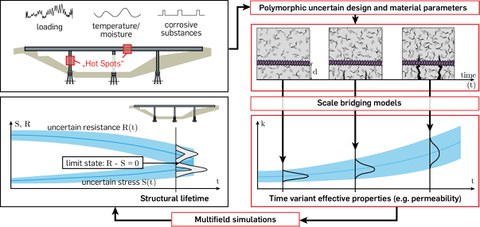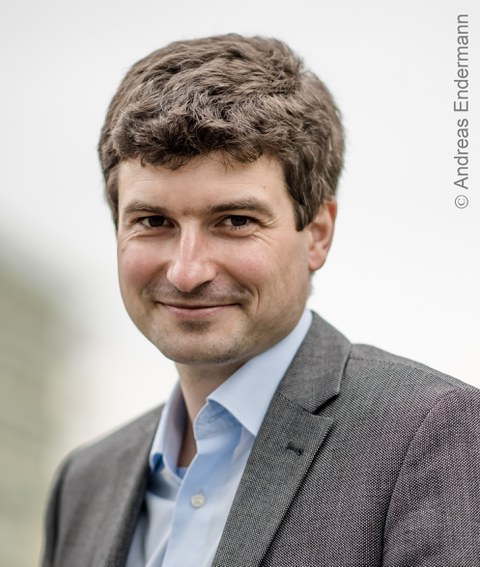Optimization approaches for robust and durable reinforced concrete and fibre concrete structures under consideration of scale bridging polymorphic uncertainty modelling
A continuation of the topic is currently taking place in the second project phase.
The objective of this project is the development of computational reliability and optimization methods for the lifetime oriented design of reinforced and steel fibre concrete structures, which allow to follow the influence of uncertain, i.e. non-deterministic describable design parameters and uncertain time variant structural actions on the structural state throughout its life. Thereby, interactions between loading induced damage and environmentally induced deterioration processes are considered by multiscale models in conjunction with physically sound durability models, see Figure 1. The structural reliability is computed by multifield simulations under consideration of polymorphic uncertain data (stochastic parameters, intervals and fuzzy numbers as well as generalized uncertainty models).

Multiscale modelling strategy to follow time variant uncertainties through various spatial scales
For the numerical structural design, optimization approaches with polymorphic uncertain data are developed, with the structural robustness and durability as the objectives, considering accepted probabilistic serviceability and safety measures and aspired lifetimes as constraints. The design parameters and respective critical components of the structure (“hot spots”) are determined from sensitivity analysis. For solving the resulting optimization problems considering uncertainties of the loading and of deterioration processes, respectively, the original structural model will be substituted by highly efficient surrogate models. In addition, a concept for numerical accelerated life testing is developed.
Selected scientific questions addressed in the first phase of the project include:
- How do uncertainties connected with design parameters at the lower (material) scale (e.g. concrete composition, fibre distribution, steel-concrete bond properties), propagate through the scales and affect the concrete durability and, as a consequence, the structural reliability?
- How does the reinforcement technology (fibres vs. conventional reinforcement) affect the robustness of the structure? How could hybrid approaches further improve robustness?
- How do construction related tolerances and human induced imprecisions affect the structural reliability and lifetime?
Essential project findings
- sub-modelling strategy for the simulation and analysis of crack pattern in reinforced concrete structures
- uncertain bond behaviour has a main influence on the crack behaviour
- load displacement curve is not significantly influenced by the bond behaviour
- reduction of the computational effort during optimization by space subdiving method and multilevel surrogate modelling strategy
- intervall radii have a main influence on the optimization results
- small variations of the stochastic parameters can have a huge influence on the limit state function and the objective function

M.Sc. Roskosch
M.Sc. Stefanie Roskosch
Ruhr-Universität Bochum
Lehrstuhl für Statik und Dynamik

M.Sc. Edler
M.Sc. Philipp Edler
Ruhr-Universität Bochum
Lehrstuhl für Statik und Dynamik
-
Freitag, S.; Edler, P.; Kremer, K.; Meschke, G.:
Multilevel surrogate modeling approach for optimization problems with polymorphic uncertain parameters.
International Journal of Approximate Reasoning, 119, 2020, pp. 81 – 91, Link
-
Freitag, S.; Kremer, K.; Edler, P.; Hofmann, M.; Meschke, G.:
Structural Reliability and Durability Assessment of Reinforced Concrete Structures.
In: Beer, M.; Zio, E. (eds.), Proceedings of the 29th European Safety and Reliability Conference (ESREL 2019), Hannover, Germany, 2019, Research Publishing, Singapore, 2019, pp. 2229 - 2236 Link
-
Freitag, S.; Edler, P.; Kremer, K.; Hofmann, M.; Meschke, G.:
Optimization of structures under consideration of polymorphic uncertain parameters.
In: 5th International Conference on Soft Computing and Optimization in Civil, Structural and Environmental Engineering (CIVIL-COMP-OPTI 2019), Riva Del Garda, Italy, 2019
-
Kremer, K.; Edler, P.; Freitag, S.; Meschke, G.:
Sub-Modeling Approach to Investigate the Cracking Behavior of Reinforced Concrete Structures Considering Polymorphic Uncertainty.
In: Proceedings of the ECCOMAS Thematic Conference – Computational Methods in Multi-Scale, Multi-Uncertainty and Multi-Physics Problems (CM4P), Porto, Portugal, 2019, pp. 27 – 28
-
Edler, P.; Freitag, S.; Kremer, K.; Hofmann, M.; Meschke, G.:
Optimization of reinforced concrete structures under consideration of scale bridging uncertainties.
In 3rd ECCOMAS Thematic Conference on Uncertainty Quantification in Computational Sciences and Engineering (UNCECOMP 2019), Crete, Greece, 2019
-
Edler, P.; Freitag, S.; Kremer, K.; Meschke, G.
Optimization Approaches for the Numerical Design of Structures under Consideration of Polymorphic Uncertain Data. ASCE-ASME Journal of Risk and Uncertainty in Engineering Systems, Part B: Mechanical Engineering, 2019, 5 (4), 2019, 041013 Link
-
Mäck, M.; Caylak, I.; Edler, P.; Freitag, S. Hanss, M.; Mahnken, R.; Meschke, G.; Penner, E.:
Optimization with constraints considering polymorphic uncertainties.
Surveys for Applied Mathematics and Mechanics (GAMM-Mitteilungen), 2019, Link
-
Kremer, K.; Edler, P.; Miska, N.; Leichsenring, F.; Balzani, D.; Freitag, S.; Graf, W.; Kaliske, M.; Meschke, G.:
Modeling of structures with polymorphic uncertainties at different length scales.
Surveys for Applied Mathematics and Mechanics (GAMM-Mitteilungen), 2019, Link -
Freitag, S.:
Statische Berechnungen mit polymorph unscharfen Daten.
In: Freitag, S.; Geierhos, M.; Asmani, R.; Haug, J.I. (Hrsg.), Unschärfe – Der Umgang mit fehlender Eindeutigkeit. Nordrhein-Westfälische Akademie der Wissenschaften und der Künste – Junges Kolleg, Verlag Ferdinand Schöningh, 2018, S. 129 – 141
-
Freitag, S.; Edler, P.; Kremer, K.; Hofmann, M.; Meschke, G.:
Optimization Approaches for Durable Reinforced Concrete Structures considering Interval and Stochastic Parameter Uncertainty.
Proceedings in Applied Mathematics and Mechanics, 18 (1), 2018, pp. 1 – 4, Link
-
Kremer, K.; Edler, P.; Freitag, S.; Hofmann, M.; Meschke, G.:
Numerical durability simulation of reinforced concrete structures under consideration of polymorphic uncertain data.
In: Caspeele, R.; Taerwe, L.; Frangopol, D.M (eds.), Life-Cycle Analysis and Assessment in Civil Engineering: Towards an Integrated Vision, Proceedings of the Sixth International Symposium on Life-Cycle Civil Engineering (IALCCE 2018), Ghent, Taylor & Francis, London, 2018, pp. 1089 – 1096 -
Kremer, K.; Edler, P.; Freitag, S.; Hofmann, M.; Meschke, G.:
Multiscale Deterioration Modelling of Reinforced Concrete Structures considering Polymorphic Uncertainties
In: Schlangen, E.; de Schutter, G.; Šavija, B.; Zhang, H.; Romero Rodriguez, C. (eds.), Proceedings of the Symposium on Concrete Modelling - CONMOD2018, 72th RILEM-week, TU Delft, 2018, pp. 281 – 284 -
Freitag, S.; Muhanna, R.L.; Mullen, R.L. (eds.)
Special Issue on: Computing with Polymorphic Uncertain Data
International Journal of Reliability and Safety, 12 (1/2), 2018, Link -
Edler, P.; Freitag, S.; Kremer, K.; Meschke, G.
Optimization of Durability Performance of Reinforced Concrete Structures under Consideration of Polymorphic Uncertain Data
In: Proceedings of the joint ICVRAM ISUMA UNCERTAINTIES conference, Florianópolis, 2018, pp. 1 – 19 -
Freitag, S.; Edler, P.; Kremer, K.; Meschke, G.
Surrogate modelling for solving optimization problems with polymorphic uncertain data
In: Proceedings of the 8th International Workshop on Reliable Engineering Computing (REC 2018), Liverpool, 2018, pp. 31 – 39 -
Freitag, S.; Edler, P.; Kremer, K.; Meschke, G.
Optimization with Polymorphic Uncertainty Models for the Design of Durable Reinforced Concrete Structures
In: Proceedings of the 13th World Congress on Computational Mechanics (WCCM 2018), New York, 2018
- Freitag, S.; Kremer, K.; Hofmann, M.; Meschke, G.
Numerical Design of Reinforced Concrete Structures under Polymorphic Uncertain Conditions.
In: Bucher, C.; Ellingwood, B.R.; Frangopol, D.M. (eds.), Safety, Reliability, Risk, Resilience and Sustainability of Structures and Infrastructure, Proceedings of the 12th International Conference on Structural Safety and Reliability (ICOSSAR 2017), Vienna, 2017, pp. 1535 – 1542 - Kremer, K.; Freitag, S.; Hofmann, M.; Meschke, G.
Deterioration of Reinforced Concrete Structures under consideration of Polymorphic Multiscale Uncertainty Modelling
In: Papadrakakis, M.; Papadopoulos, V.; Stefanou, G. (eds.), Proceedings of the 2nd ECCOMAS Thematic Conference on Uncertainty Quantification in Computational Sciences and Engineering (UNCECOMP 2017), Rhodes Island, 2017


